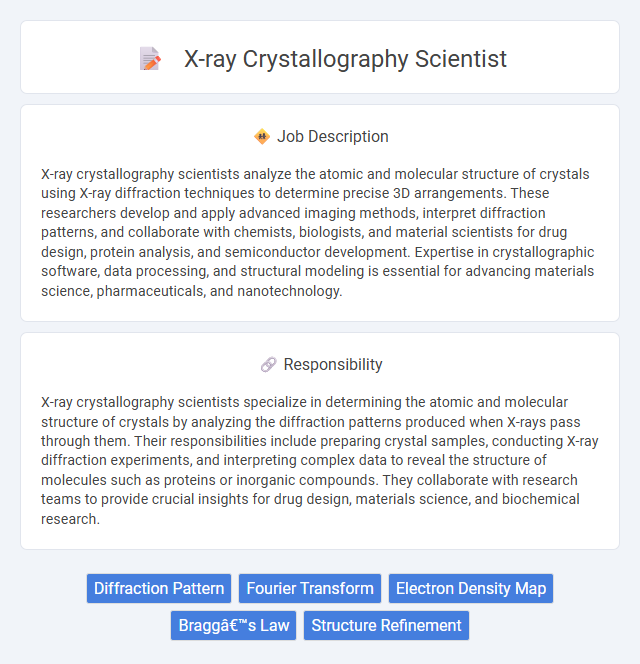
X-ray crystallography scientists analyze the atomic and molecular structure of crystals using X-ray diffraction techniques to determine precise 3D arrangements. These researchers develop and apply advanced imaging methods, interpret diffraction patterns, and collaborate with chemists, biologists, and material scientists for drug design, protein analysis, and semiconductor development. Expertise in crystallographic software, data processing, and structural modeling is essential for advancing materials science, pharmaceuticals, and nanotechnology.
Individuals with strong analytical skills and a keen eye for detail are likely well-suited for a career in X-ray crystallography, given the precision required in interpreting diffraction patterns. Those who thrive in environments requiring patience and persistence may find the repetitive data collection and complex problem-solving aspects manageable. Physical conditions such as good vision and steady hand coordination might also increase the probability of success in this scientific discipline.
Qualification
X-ray crystallography scientists typically require a Ph.D. in chemistry, biochemistry, physics, or materials science, specializing in crystallographic methods and structural analysis. Proficiency in techniques such as X-ray diffraction, data collection, and computational modeling is essential for deciphering atomic and molecular structures. Experience with software tools like SHELX, PHENIX, or CCP4 enhances the ability to interpret crystallographic data and contribute to research in drug design, material science, or protein engineering.
Responsibility
X-ray crystallography scientists specialize in determining the atomic and molecular structure of crystals by analyzing the diffraction patterns produced when X-rays pass through them. Their responsibilities include preparing crystal samples, conducting X-ray diffraction experiments, and interpreting complex data to reveal the structure of molecules such as proteins or inorganic compounds. They collaborate with research teams to provide crucial insights for drug design, materials science, and biochemical research.
Benefit
The benefit of a career in X-ray crystallography science likely includes opportunities to contribute to the understanding of molecular structures, which can accelerate drug discovery and materials science advancements. Scientists in this field probably gain access to cutting-edge technology and collaboration with interdisciplinary teams, enhancing their professional development. This role may also offer job stability and demand due to the growing importance of structural biology and chemistry in research and industry.
Challenge
X-ray crystallography scientists likely face significant challenges in obtaining high-quality crystalline samples essential for accurate structural analysis. The complexity of interpreting diffraction patterns requires advanced expertise and meticulous attention to detail. They probably encounter frequent trial-and-error processes to optimize experimental conditions and overcome technical limitations.
Career Advancement
X-ray crystallography scientists specialize in determining the atomic and molecular structure of crystals, essential for advancements in pharmaceuticals, materials science, and chemistry. Career advancement opportunities include roles such as senior research scientist, laboratory manager, or academic professor, often requiring expertise in advanced computational modeling and interdisciplinary collaboration. Gaining experience with state-of-the-art crystallographic software and publishing research in peer-reviewed journals significantly enhances prospects for leadership positions and grant funding.
Key Terms
Diffraction Pattern
X-ray crystallography scientists analyze diffraction patterns produced when X-rays interact with crystalline materials to determine atomic and molecular structures. They interpret these patterns by measuring the angles and intensities of diffracted beams, enabling precise modeling of complex biomolecules and materials. Expertise in data processing software and crystallographic refinement techniques is essential for accurate structural elucidation.
Fourier Transform
X-ray crystallography scientists utilize Fourier Transform techniques to reconstruct electron density maps from diffraction patterns, enabling precise determination of molecular structures. The Fourier Transform converts complex diffraction data into spatial information, critical for revealing atomic arrangements within crystals. Mastery of computational algorithms for Fourier analysis is essential for interpreting crystallographic data and advancing structural biology research.
Electron Density Map
X-ray crystallography scientists specialize in determining the atomic structure of crystalline materials by analyzing electron density maps derived from X-ray diffraction patterns. They interpret these maps to identify the precise arrangement of atoms within macromolecules, which is essential for understanding molecular function and designing targeted drugs. Expertise in software tools for modeling electron density enables these scientists to achieve high-resolution structural insights critical for advancements in biochemistry and pharmacology.
Bragg’s Law
X-ray crystallography scientists utilize Bragg's Law to determine the atomic and molecular structure of crystals by analyzing the diffraction patterns of X-rays scattered off crystal lattices. They calculate the angles and intensities of diffracted beams, applying the equation nl = 2d sin th, where n is an integer, l is the wavelength, d is the distance between crystal planes, and th is the angle of incidence. This process reveals precise three-dimensional structures essential for advancements in chemistry, biology, and materials science.
Structure Refinement
X-ray crystallography scientists specialize in structure refinement by interpreting diffraction patterns to determine the precise atomic arrangement within crystals. They employ advanced computational algorithms to optimize electron density maps, ensuring accurate modeling of molecular structures. Expertise in software such as PHENIX or REFMAC is essential for refining crystal structures to high resolution, facilitating drug design and material science applications.
 kuljobs.com
kuljobs.com